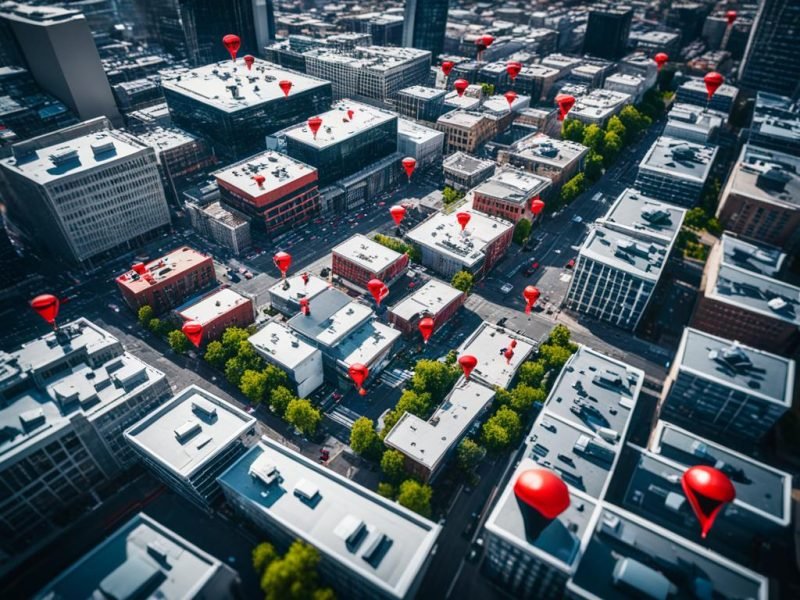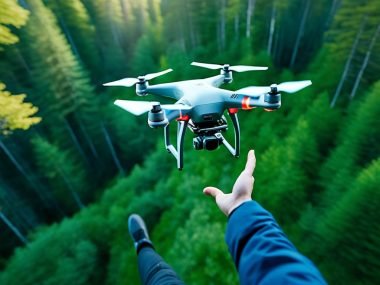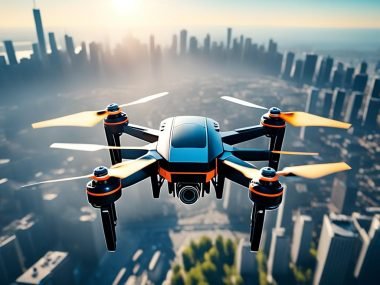Our DJI drones take to the sky, capturing moments and doing tasks with precision. They open up new chances from up high. As we use these drones for our goals and creativity, it’s important to think about DJI Drone tracking. This affects our privacy. Looking into Drone traceability brings up big questions. One is if a drone can reveal secrets about its prior flights, Can A DJI Drone Be Traced Back To You? This question isn’t just about if it’s possible. It’s also about keeping control over our tools and their impact.
Key Takeaways
- The essentiality of understanding DJI drone tracking systems to ensure privacy.
- Navigating drone traceability to manage both accountability and autonomy.
- The importance of unbinding your drone from your account to prevent tracing back.
- Potential implications and liabilities connected with drone traceability.
- Strategies for securing your information in the sphere of drone use.
Understanding DJI Drone Traceability
In the world of fast-moving drone tech, knowing how to trace your DJI drone matters. It is for safety and following rules. DJI drone tech helps with keeping tabs on drone ownership and traceability. This promotes accountability for drone pilots.
GPS Tracking Capabilities of DJI Drones
DJI has added GPS tracking to its drones, which is a big step forward. This tracking lets users see where their drone is in real-time. It helps in getting drones back if lost or stolen. GPS also keeps drones flying safely in the right areas.
DJI Flight Logs: A Record of Flight Data
The flight data logs show how open DJI is about drone operations. These logs record every detail of flights, from where they go to how they fly. It’s a goldmine of info for checking on flight habits and data.
The Range and Limitations of Drone Tracking Technologies
The tracking tech in DJI drones is strong, yet it has limits. The drones can only hold so much data before they need to delete old records. This means some past flight data might get lost. Also, while tech like Remote ID and ADS-B boosts awareness, there are limits to their power and rules.
DJI Drone Registration and Its Impact on Owner Privacy
Registering a DJI drone is crucial for legal flying. It ensures users follow the law. But, when we look at DJI drone registration, we see concerns about privacy. Tracking who owns the drone can put our private information at risk.
The Process of Registering a DJI Drone
To register a DJI drone, you need to give personal details. This step helps track who owns the drone. It’s important for following airspace rules. But, it also means our information is linked to our drones. Many drone users worry about what this means for their privacy.
How Registration Data Could Be Used to Trace Ownership
Registration data is key for tracking drones. It connects the drone to its owner. This could put our privacy at risk. Law enforcement and flight authorities use this data. They do this to hold drone users accountable. However, it also means our privacy could be under watch.
DJI drone registration and privacy have a delicate balance. We have to think about safety and rules versus our privacy rights. It’s important to know how our information is used. We should keep up with drone tracking tech. This knowledge helps protect us as drone users and owners.
Account Binding and Its Role in Securing DJI Drone Ownership
Account binding is key in securing drone ownership. It ensures privacy and responsible use. DJI leads in drone tech, offering ways to link your device to your account. This strengthens your grip on your personal assets. Learn about unlinking your drone and keeping your account safe to protect your ownership privacy.
What Happens When You Unbind a DJI Drone From Your Account
Unbinding a DJI drone is a serious move. It’s about passing control and removing your identity from the device. It’s crucial when you’re giving the drone to a new owner. It shields you from legal problems or misuse by the new owner. Account binding frees flight logs and data from your account. This makes the ownership transfer smooth and secure.
Managing Your DJI Account to Maintain Ownership Privacy
To own a DJI drone responsibly, you must manage your account well. Keeping your drone’s details private means being careful with your account. This involves logging out from other devices and updating your security settings. Consider these points to keep your account private:
- Account Credentials: Change your password often and use two-factor authentication for better security.
- Footprint Reduction: Clear all data from the drone and apps after unbinding.
- Remote Logout: Make sure to log out from all devices using the DJI app if you’re transferring your drone to ensure your online privacy.
| Before Unbinding | After Unbinding |
|---|---|
| Ownership linked to your DJI account | Ownership responsibility transferred |
| Flight logs available under your account | Flight data no longer associated with you |
| Potential liability for drone’s activities | Minimized legal risk and privacy concerns |

Account binding does more than manage drones; it protects your ownership rights. Deciding to unbind your drone means you’re leaving its past activities behind. This act secures drone ownership for the new user. A reliable connection between drone and owner via the DJI app brings confidence. It also avoids problems, important in today’s world where security and privacy are valued.
Drone Ownership Tracking: Legal and Ethical Considerations
Exploring legalities of drone tracking shows us how laws intertwine with drone tech growth and privacy expectations. The main issue is designing laws for responsibility and protecting against spying and privacy breaches due to drone privacy concerns.
Law enforcement’s interest in drones is rising, for tasks like search and rescue to event monitoring. This use raises questions about ethical drone tracking. It’s crucial to make laws that prevent overwatch while allowing drones to be useful.
As drone use grows, we must look at legalities of drone tracking across different situations. We need to find the right balance between safety and freedom. The ethical responsibility might also include manufacturers making information safe to prevent misuse.
- Surveying Legal Guardrails: Understanding the extent to which laws permit drone tracking
- Evaluating Ethical Boundaries: Considering privacy rights and preventive measures against unauthorized tracking
- Holding Manufacturers Accountable: The role of drone producers in securing user data
Privacy is seen as key to democracy, so discussing legalities of drone tracking must align with valuing freedom. In this drone innovation era, pushing for laws that respect privacy while handling drone privacy concerns is important.
In short, laws around drone tracking are complex yet vital. Finding a balance legally and ethically involves law introspection, a fight for privacy, and a commitment from drone makers.
Real-World Scenarios: Can A Dji Drone Be Traced Back To You?
Wondering Can A Dji Drone Be Traced Back To You? isn’t just theoretical. It comes up in real life too. Imagine your favorite drone gets stolen. You’d want to know if you could track it like a lost phone.
Yet, the issue is DJI drones don’t have built-in long-distance tracking. If your drone is stolen or lost, finding it might be hard. The search is mostly confined to how far the controller can work.
Some suggest keeping tabs on flight data or noting the serial number of the drone. But these methods rarely work well. The big question, Can A Dji Drone Be Traced Back To You?, often leads to thinking about getting help from the police. However, how well this works depends on local law enforcement.
| Scenario | Traceability Options | Limitations | Recommendations |
|---|---|---|---|
| Stolen Drone | Controller Range, Flight Data | Range Constraints, Data Overwriting | Immediately Inform Authorities |
| Lost Drone | Serial Number Record, Last Known GPS Location | Potential Data Inaccessibility, GPS Limits | Use Manufacturer’s App/Service |
| Drone Registration | User Account, Drone Serial Number | Privacy Concerns, Regulatory Dynamics | Maintain Accurate Registration |
Facing the question, Can A Dji Drone Be Traced Back To You?, the answers aren’t simple. But knowing about the limits and solutions can help drone owners. This way, they can feel more prepared and confident.
As we delve into these situations, the link between technology and taking responsibility is key in managing drone traceability.
- Secure your drone’s information
- Record serial numbers and relevant data
- Stay aware of drone tracking technologies and limitations
- Connect with local law enforcement if theft occurs
Staying updated with advancements and laws is crucial when answering Can A Dji Drone Be Traced Back To You?. As responsible owners, we should keep up with drone tracking developments and safeguard our drones.
Can Drones Be Tracked Remotely by the Authorities?
Advances in technology are reshaping how authorities track drones. There are various tools and methods available under regulatory compliance. These help law enforcement track unmanned aerial vehicles (UAVs).
The Extent of Law Enforcement’s Ability to Track Drones
Tracking drones involves more than following their movement. It includes managing data and working with manufacturers. The ability to track effectively depends on accessing flight data and the drone operator’s use of their DJI account. Remote ID gives authorities insights into the drone’s identity and location.
Yet, tracking drones effectively has its challenges. Some authorities can track and monitor drones, especially those used in illegal activities. But this relies heavily on data from drone operators and manufacturer cooperation. This shows how law enforcement must navigate through technology and jurisdiction.
Regulatory Compliance and Remote ID Implementation
Regulatory compliance balances privacy, security, and safety needs. Remote ID helps with drone tracking and accountability. It makes it easier for authorities to track misused drones or those threatening airspaces.
While Remote ID marks progress, its practical use and enforcement have ongoing challenges. It’s essential to keep regulations updated with drone technology advancements. This shows the ongoing effort to regulate technology effectively.
| Requirement | Benefit | Challenge |
|---|---|---|
| Remote ID | Enhanced tracking and accountability | Dependence on the drone’s broadcast capability |
| Flight Data Access | Potential for real-time location tracking | Retrieval complexities and data storage limitations |
| Authority Collaboration | Increased operational efficiency | Varied technical capabilities across jurisdictions |
Remote ID and strict regulations have improved drone tracking. However, achieving full aerial security and responsible drone use faces challenges. These include enforcement issues and the protection of civil liberties.
Consumer Concerns: Drone Privacy and Potential Misuse
Drones are becoming more popular, and with that, we see real worries about drone privacy concerns. People are uneasy about others getting their personal details without permission and the potential drone misuse. These fears make it clear we need to set clear rules and take good security steps.
To keep a good balance between new tech and privacy, we must protect drone users’ rights. Though drones getting GPS and flight logs has made them better, it also brought more privacy issues. We need to look into how these features could be wrongly used without the right rules.
Users fear that the data drones collect could be tracked back to them, by the government or even smart third parties. This worry isn’t just about potential drone misuse, but also about how to defend against these situations. The table below shows common worries people have about drone privacy and misuse.
| Consumer Concern | Privacy Implication | Measures for Protection |
|---|---|---|
| Information Access | Data could be traced back to individuals. | Encrypted communications and secure flight data handling. |
| GPS Tracking | Real-time location tracking raises surveillance fears. | Geofencing and user-controlled location sharing settings. |
| Data Logging | Persistent logs may reveal user flight patterns. | Anonymization of stored data and clear data retention policies. |
| Registration Databases | Public databases may expose personal information. | Access control and registration information protection. |
We must turn our worries into specific plans to make sure drone privacy concerns don’t take away from the tech’s benefits. Our goal is to always look for ways to keep users safe while pushing forward with drone advancements.
The Importance of Responsible Drone Ownership
Exploring modern drone use shows us that responsible drone ownership is essential. It’s not just being courteous; it’s about respect and legality. We must use drones in ways that respect privacy and follow laws.
To keep our drones safe and legal, there are specific actions to take. Let’s look at how we can achieve these standards.
Adhering to Drone Flying Regulations
Talking about adhering to regulations means making an effort to stay legal. That includes registering our drones and knowing the laws. Avoiding no-fly zones is part of it.
By following these rules, we keep the drone community honest and avoid legal trouble.
Best Practices for Protecting Your Drone From Misuse or Theft
To protect our drones, we need to take steps. Start with basic things like secure storage and careful sharing. Also, keep a record of your drone’s serial number.
Plus, make sure drones aren’t linked to personal when you’re not using them. This prevents misuse or theft.
| Best Practice | Benefit |
|---|---|
| Unbind DJI Account After Each Use | Prevents unauthorized access and protects your privacy. |
| Regular Firmware Updates | Keeps drone’s security features up to date. |
| Use Strong Passwords | Enhances security of drone’s associated accounts and apps. |
| Track Flight Logs | Helps reconstruct events in case of incidents or misuse. |
| Enable Geo-Fencing | Limits drone’s operation within safe and legal boundaries. |
Using these methods builds a culture of responsible drone ownership. It helps make the drone community safer and more trustworthy. The aim is to fly freely while being highly responsible and protecting against misuse or theft.
This way, drone flying stays fun and reputable for all of us.
Tackling the Fear Factor: Theft, Loss, and Legal Ramifications
Owning a drone comes with the big worry of it getting stolen. This fear affects both hobbyists and pros. Knowing what could legally happen if your drone gets lost is key. This knowledge helps you follow the rules and keeps your drone safe from misuse.
Keeping a drone safe means more than just locking it up. It includes protecting your digital data too. Being smart about GPS tracking and understanding the importance of flight logs is crucial. This keeps you safe from the effects of theft or losing your drone.
If your drone gets stolen, act fast. Tell the authorities right away and check if there’s flight data linked to your account. This might help get your drone back. But remember, finding and recovering stolen drones can be hard.

| Preventive Action | Description | Impact on Fear of Theft |
|---|---|---|
| Adherence to Regulations | Following all local and federal drone laws to ensure compliance. | Reduces risk of penalties and aids in legal protection against theft. |
| Securing Account Data | Implementing strong passwords and unbinding accounts when necessary. | Lowers the chances of unauthorized account access post-theft. |
| Understanding GPS and Log Data | Being aware of your drone’s tracking capabilities and data storage. | Enhances ability to identify the drone location and usage after theft. |
| Immediate Theft Reporting | Notifying authorities promptly after recognizing your drone is stolen. | May increase the likelihood of recovery and proper investigation. |
We must embrace a preemptive mindset, with our activities grounded in foresight and an astute application of security measures aimed at precluding theft and addressing the potential legal complexities should our drones go missing.
- Register and clearly label your drone with contact information.
- Invest in tracking technology to monitor your drone’s whereabouts.
- Maintain a close watch over your drone during operation and storage.
This table is a quick guide for drone owners about how to stay safe. Following these tips can lessen your worry about theft. It also prepares you for any legal issues if your drone gets lost.
Conclusion
The topic of if a DJI Drone can be traced back to its owner isn’t simple. DJI drones come with GPS and detailed flight logs. This means they mix your info into the drone’s system. While they aim to keep things safe and lawful, they also touch on privacy and data safety.
Tracking who owns a drone is complex. DJI’s drone registration is tricky. It helps with responsible use and follows the law. Yet, it also makes us balance safety and our right to privacy. Knowing this, we must be smart and active in protecting our privacy while using drones.
Using modern drones means balancing tech advances with privacy and ethics. As drone users, we have to stay informed about drone tracking changes. We should keep our DJI drone registration and account details tight. Plus, be mindful of privacy. This way, we can use drones wisely and respectfully.







